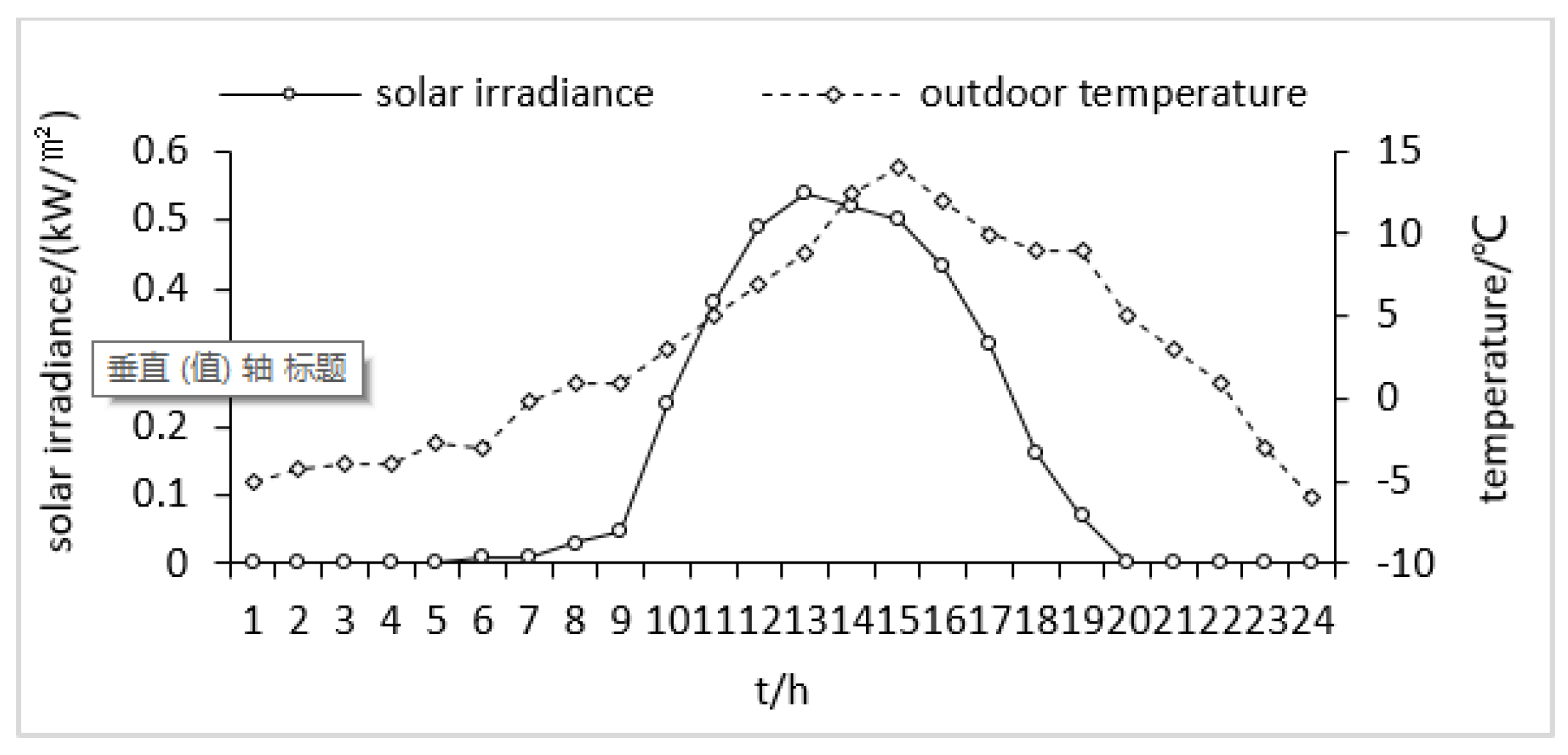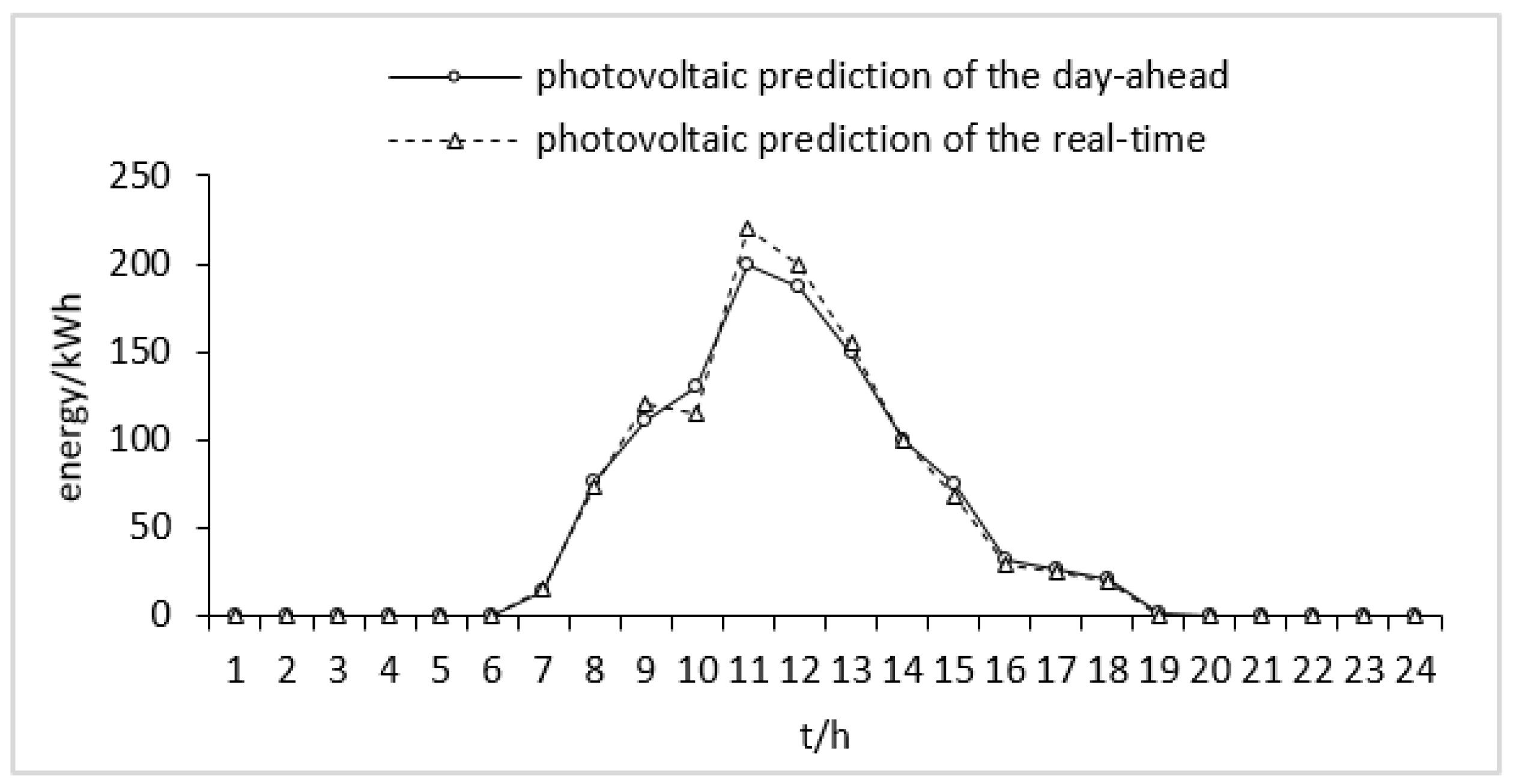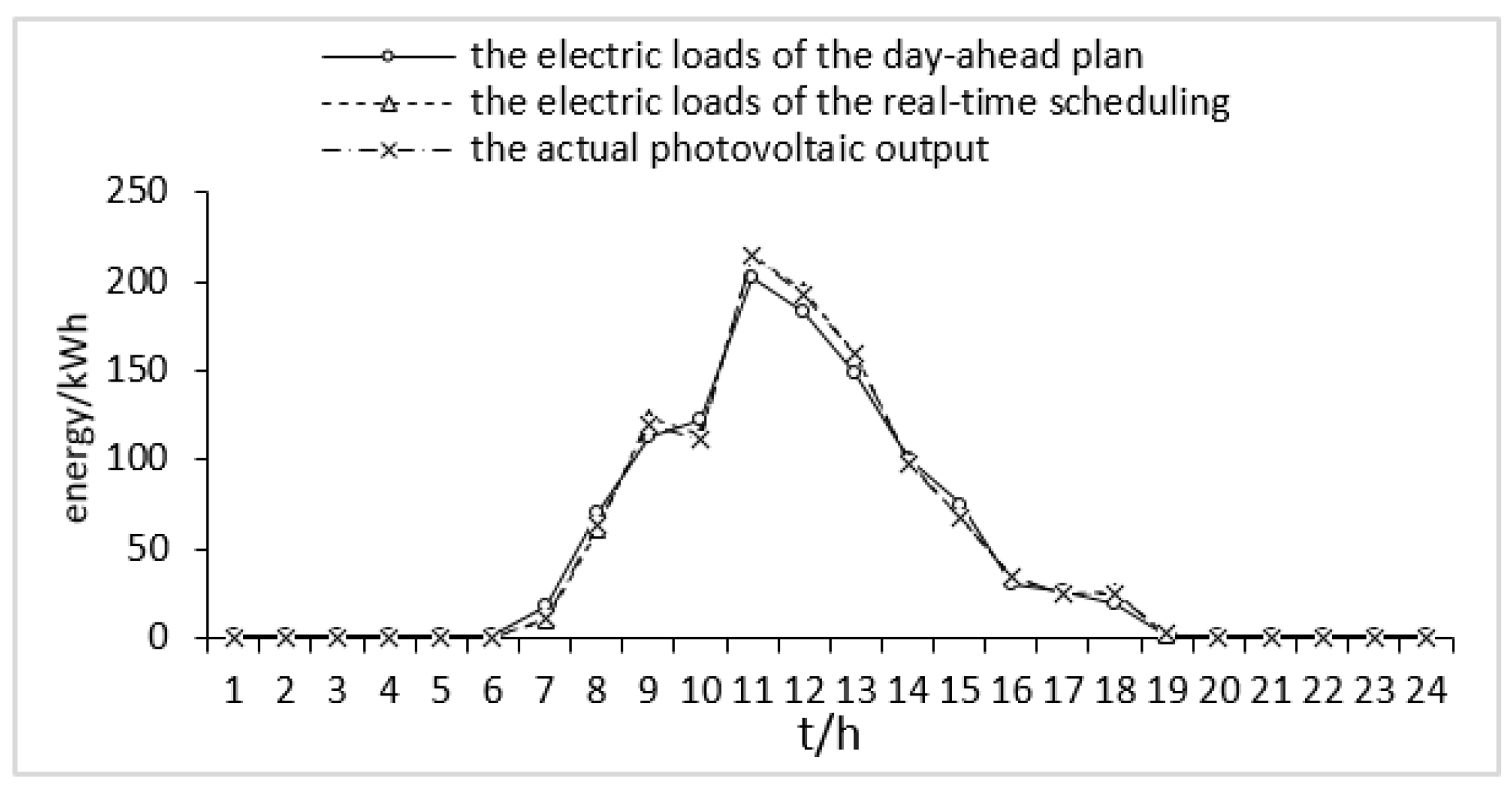Analysis of the Day-ahead Deviation Plan and Research on the Real-time Scheduling of Photovoltaic Greenhouses Based on Exergy Theory
Abstract
:1. Introduction
2. Heat Deviation Model of a Photovoltaic Greenhouse Micro-Integrated Energy System Based on Exergy Analysis
2.1. Exergy Loss Model During the Heating Process of Photovoltaic Greenhouse Pipes
2.1.1. Exergy Loss Model of Heat Transfer Between Two Working Substances
2.1.2. Exergy Loss Model of Water Friction in the Heating Pipes
2.2. The Demand Thermal Exergy Model of Photovoltaic Greenhouse Micro-Integrated Energy System
2.2.1. The Thermal Exergy Model of Natural Heat Dissipation from the Greenhouse to the Outside
2.2.2. The Increased Thermal Exergy in the Greenhouse Because of Solar Radiation
3. Real-Time Scheduling Based on Deviation Correction of the Day-Ahead Plan
3.1. Objective Function
3.2. Constraints
3.3. Solution Flow Chart
- 1
- Input day-ahead and real-time solar irradiance, outdoor temperature, electric loads, thermal loads and other data, and input various parameters required in the calculation model;
- 2
- Calculate the heat required deviation , photovoltaic power generation deviation and adjustable range of multi-form energy storage in the real-time stage;
- 3
- Judge whether the heat required deviation and photovoltaic power generation deviation in the real-time stage can be offset through the electric-thermal link (the electric-thermal link is the far-infrared heating device by default in this paper). If the offset happens, the multi-form energy storage will not be adjusted.
- 4
- If , it indicates that there is excess energy. The excess energy will be stored within the increased adjustable range of multi-form energy storage. If , it indicates that multi-form energy storage is required to provide the part of energy that is insufficient in the greenhouse. The insufficient energy will be provided within the decreased adjustable range of multi-form energy storage, so as to make the objective function as optimal as possible.
- 5
- Output the adjustment of multi-form energy storage and electric loads.
4. Example
4.1. Basic Data of System and Example Design
- 1
- The thermal exergy calculation and analysis of the photovoltaic greenhouse micro-integrated energy system is performed to verify the effectiveness of the deviation model for a photovoltaic greenhouse.
- 2
- The paper selects one hour as the scheduling duration and performs the real-time scheduling analysis based on [2]. By doing these, the paper corrects the deviation of the day-ahead plan and verifies the effectiveness of the real-time scheduling model.
4.2. Example Results and Analysis
4.2.1. Basic Data of the Example
4.2.2. The Thermal Exergy Analysis of the Photovoltaic Greenhouse Micro-Integrated Energy System
4.2.3. The Real-Time Scheduling Analysis of the Photovoltaic Greenhouse Micro-Integrated Energy System
5. Conclusions and Outlook
- 1
- This paper proposes a deviation model of heat required for photovoltaic greenhouse based on the exergy analysis method. The model not only accounts for the non-negligible exergy loss during the heating process of the pipes, but also considers the difference between the heat and thermal exergy affected by the actual indoor temperature. It can reflect the actual heat required more accurately, so that the greenhouse temperature is more suitable for plant growth. Based on the above analysis, the real-time optimization scheduling model is established. The goal of the real-time scheduling model is to minimize the absolute value of the difference between the energy supply and demand prediction deviation to be corrected and the adjustment of multi-form energy storage and electric loads.
- 2
- The example shows that compared with [2], the heat required of greenhouse during the real-time scheduling stage based on the exergy theory can more accurately reflect the actual heat required. The proposed real-time optimal scheduling model can make full use of the characteristics of multi-form energy storage and adjustable loads. As a result, it corrects the day-ahead plan deviation so that the temperature is more suitable for plant growth and agricultural production is promoted. In addition, it improves the local consumption of photovoltaic power effectively and reduces the cost of farmers.
- 3
- For other polymorphic source-storage-load micro-integrated energy systems with similar configurations, the models proposed in this paper are equally applicable. In addition, this paper is an energy optimal scheduling of the interior of the greenhouse. Micro-integrated energy system community is formed by multiple regional-level photovoltaic greenhouses. The next step to be studied is the energy mutual aid scheduling between communities.
Author Contributions
Funding
Conflicts of Interest
Nomenclature
| Notation | Specification |
| the temperature of the heat source, °C | |
| the reference temperature, °C | |
| the indoor temperature of greenhouse during the t period (current time), °C | |
| , , | the temperature of heat resource’s working substance, water and thermal energy storage equipment’s working substance during the t period, °C |
| the initial thermodynamic temperature of working substance, °C | |
| the thermodynamic temperature of reference state, °C | |
| the difference between the supply and return water temperature, °C | |
| the design temperature of greenhouse during t + 1 scheduling period, °C | |
| the outdoor temperature during t period, °C | |
| , | the design target temperature of biogas slurry and water during t + 1 scheduling period, °C |
| , | the temperature of biogas slurry and water during t period, °C |
| the accepted thermal exergy of the system, kWh | |
| exergy loss of heat transfer process from the heat resource to the water, kWh | |
| exergy loss of water friction, kWh | |
| exergy loss of heat transfer process from the heat resource to the thermal energy storage equipment, kWh | |
| exergy loss of heat transfer process from the thermal energy storage equipment to the water, kWh | |
| the enthalpy exergy of working substance’s which mass is m, kWh | |
| , | The enthalpy exergy change of working substance a and b, kWh |
| the exergy loss when the working substance a transfers heat to b, kWh | |
| , | the enthalpy exergy difference of the heat resource’s working substance and the pipes’ water, kWh |
| , | the enthalpy exergy of the heat resource’s working substance before and after heat transfer, kWh |
| , | the enthalpy exergy of water before and after heat transfer, kWh |
| the demand thermal exergy of greenhouse, kWh | |
| the thermal exergy of natural radiating, kWh | |
| the increased thermal exergy in the greenhouse because of solar radiation, kWh | |
| the demand thermal exergy to warm the indoor air of greenhouse, kWh | |
| the thermal exergy that is to be provided for reservoir and biogas digester, kWh | |
| the thermal exergy loss caused by enclosure structures’ radiating, kWh | |
| the thermal exergy loss of air infiltration, kWh | |
| the thermal exergy loss of ground heat transfer, kWh | |
| , | the thermal exergy of soil absorption and wall absorption, kWh |
| , | the demand thermal exergy for warming the biogas slurry and the water to the target temperature, kWh |
| the adjustment of the multi-form energy storage during the t + 1 period, kWh | |
| the maximum input energy of the multi-form energy storage, kWh | |
| the maximum output energy of the multi-form energy storage, kWh | |
| , | the input and output energy of the multi-form energy storage in the day-ahead plan during the t + 1period, kWh |
| , | the maximum input and output energy values of the multi-form energy storage after the real-time scheduling duration Δt, kWh |
| the maximum increase and of the electric loads, kWh | |
| the maximum decrease of the electric loads, kWh | |
| the adjustment of electric loads during the t + 1 period, kWh | |
| the stored energy in the multi-form energy storage during the t period (current time period), kWh | |
| the maximum increased power consumption of the i-th electric load, kWh | |
| the maximum decreased power consumption of the i-th electric load, kWh | |
| the heat of the system taken from the heat source, kWh | |
| heat required deviation, kWh | |
| heat required in the t + 1 time period of day-ahead plan, kWh | |
| heat required in the next scheduling period (that is t + 1 period) during real-time scheduling stage, kWh | |
| heat loss from heat source to greenhouse pipes terminal during the heating process, kWh | |
| demand heat for greenhouse, kWh | |
| energy loss of heat transfer process from the heat resource to the water, kWh | |
| energy loss of water friction, kWh | |
| energy loss of heat transfer process from the heat resource to the thermal energy storage equipment, kWh | |
| energy loss of heat transfer process from the thermal energy storage equipment to the water, kWh | |
| the pressure drop along the HVAC pipes during t + 1 period, m | |
| the difference of photovoltaic power generation between real-time predicted value and day-ahead predicted value during the t + 1 period, kWh | |
| the energy storage space of the multi-form energy storage, kWh |
References
- Wei, H.; Liangjun, G.; Liangliang, H. Day-ahead Optimal Scheduling of Regional Integrated Energy System Participating in Dual Market. AEPS 2019, 43, 68–82. [Google Scholar]
- Wang, Y. An Optimization Method for Local Consumption of Photovoltaic Power in a Facility Agriculture Micro Energy Network. Energies 2018, 11, 1503. [Google Scholar] [CrossRef]
- Weizhou, W.; Fuchao, L.; Jianhua, Y. Optimization of the Micro Energy Grid of PV Intelligent Agricultural Greenhouse Based on Time-shifting Agricultural Load. J. CAU 2018, 23, 160–168. [Google Scholar]
- Xin, Z.; Man, Z.; Weizhou, W. Scheduling optimization for rural micro energy grid multi-energy flow based on improved crossbreeding particle swarm algorithm. Trans. CSAE 2017, 33, 157–164. [Google Scholar]
- Yanfei, G.; Qiang, W.; Lin, C. Efficiency analysis model of integrated energy system based on the exergy efficiency. RES 2017, 35, 1387–1394. [Google Scholar]
- Leilei, L. Energy and Exergy Analysis of Air-conditioning Room in Summer. Master’s Thesis, Donghua University, Shanghai, China, 2016. [Google Scholar]
- Lei, W. Exergy Analysis of Energy Transformation Process for the Energy Storage System Combined Cooling and Heating. Master’s Thesis, Dalian University of Technology, Dalian, China, 2006. [Google Scholar]
- Geidl, M.; Andersson, G. Optimal power flow of multiple energy carriers. IEEE Trans. Power Sys. 2007, 22, 145–155. [Google Scholar] [CrossRef]
- Qiushi, H. Exergy Analysis of Ground Source Heat Pump Systems Based on TRNSYS. Ph.D. Thesis, Huazhong University of Science and Technology, Wuhan, China, 2017. [Google Scholar]
- Ishaq, H.; Dincer, I. Exergy analysis and performance evaluation of a newly developed integrated energy system for quenchable generation. Energy 2019, 179, 1191–1204. [Google Scholar] [CrossRef]
- Tengfei, M.; Junyong, W.; Liangliang, H. Energy Flow Modeling and Optimal Operation Analysis of Micro Energy Grid Based on Energy Hub. Power Syst. Technol. 2018, 42, 179–186. [Google Scholar]
- Yang, L.; Song, D.; Jintao, L. Exergy-based Energy Conservation Evaluation of Building Energy System. BEE 2019, 47, 83–86. [Google Scholar]
- Hong, L.; Yue, Z.; Xiaoou, L. Comprehensive Energy Efficiency Assessment of Park-level Multi-energy System Considering Difference of Energy Grade. Power Syst. Technol. 2019, 43, 2835–2843. [Google Scholar]
- Jiale, D.; Linxian, H.; Shiqi, S. Multi-Time Scale Rolling Scheduling Method for Combined Heat and Power System. Power Syst. Technol. 2016, 40, 191–198. [Google Scholar]
- Tao, Z.; Jiaying, Z.; Lingyun, W. Day-ahead Economic Dispatch of Electricity-Gas-Heat Integrated Energy System Considering User Behaviors. AEPS 2019, 43, 1–9. [Google Scholar]
- Xiaoli, M.; Huanna, N.; Dongli, J. Real-time energy optimal dispatch for microgrid based on day-ahead scheduling of charge state. Trans. CSAE 2016, 32, 155–161. [Google Scholar]
- Yan, Z. Research on the Building Heating and Cooling System with Exergy Analysis. Ph.D. Thesis, Hunan University, Changsha, China, 2013. [Google Scholar]
- Haiqing, Q. Exergoeconomic Analysis of Combined Cooling, Heating and Power System Based on Energy Level Concept. Ph.D. Thesis, Chinese Academy of Sciences, Beijing, China, 2016. [Google Scholar]
- Haizhu, Z.; Neng, Z.; Caixia, Y. Comprehensive Performance Evaluation Method of Hybrid Renewable Energy System Based on Exergy Theory. BEE 2018, 46, 47–52. [Google Scholar]
- Ahern, J.E. The Exergy Method of Energy Systems Analysis; China Machine Press: Beijing, China, 1984; pp. 84–113. [Google Scholar]
- Peng, W. Based on the calculation of friction loss of PCCP pipeline in large-scale water transmission project. Technol. Super. Water Res. 2019, 2, 129–131, 139. [Google Scholar]









| Equipment | Capacity/Power | Equipment | Capacity/Power |
|---|---|---|---|
| photovoltaic power | 280 kWp | physical insecticide | 0.025 kW |
| particle energy machine | 50 kW | LED fill light | 0.05 kW |
| phase change thermal storage device | 300 kWh | space electric field dehumidification | 0.024 kW |
| biogas digester | 600 kWh | far infrared heating | 0.2 kW |
| reservoir storage battery | 200 kWh 48 kWh | water and fertilizer integrated fertilization | 1.5 kW |
| water pump | 2 kW | Plasma nitrogen fixation | 0.5 kW |
| Time | 10:00 (Indoor Temperature is 20 °C) | 20:00 (Indoor Temperature is 25 °C) | 14:00 (Indoor Temperature is 30 °C) | |
|---|---|---|---|---|
| Value | ||||
| /kWh | 0.19 | 0.16 | 0.15 | |
| /kWh | 0.18 | 0.18 | 0.18 | |
| /kWh | 0.16 | 0.14 | 0.13 | |
| /kWh | 0.14 | 0.13 | 0.11 | |
| the pipes’ total exergy loss and proportion | 0.67 | 0.61 | 0.57 | |
| 11.36% | 9.58% | 19.86% | ||
| /kWh | 3.9 | 3.1 | 4.5 | |
| /kWh | −3.02 | 0 | −4.8 | |
| /kWh | 1.15 | 0.46 | 0 | |
| /kWh | 3.2 | 2.2 | 2.6 | |
| the total demand thermal exergy and proportion | 5.23 | 5.76 | 2.3 | |
| 88.64% | 90.42% | 80.14% | ||
| the total thermal exergy required /kWh | 5.9 | 6.37 | 2.87 | |
| Phase Change Thermal Storage Device/kWh | Biogas Digester /kwh | Reservoir /kwh | Storage Battery /kwh |
|---|---|---|---|
| 110 | 271 | 60 | 38 |
| Phase Change Thermal Storage Device | Biogas Digester | Reservoir | Storage Battery | Far Infrared Heating Device | The Deviation of the Heat to be Supplied | The Deviation of the Photovoltaic Prediction |
|---|---|---|---|---|---|---|
| not working | input | not working | not working | not working | −21.8kWh | 20 kWh |
| Type | Phase Change Thermal Storage | Biogas Digester | Reservoir | Storage Battery | Far Infrared Heating Device | |
|---|---|---|---|---|---|---|
| day-ahead plan | not working | input 113 kWh | not working | not working | not working | |
| real-time plan | not working | input 111.2 kWh | not working | not working | 20 kWh | |
| Type | Day-Ahead Plan | Real-Time Plan | The Increase of the Real-Time Plan over the Day-Ahead Plan | |
|---|---|---|---|---|
| Value | ||||
| consumption/kWh | 956 | 1052 | 96 | |
| percentage of consumption | 85% | 92% | 7% | |
| savings in electricity purchases | 468.5 | 515.5 | 47 | |
© 2019 by the authors. Licensee MDPI, Basel, Switzerland. This article is an open access article distributed under the terms and conditions of the Creative Commons Attribution (CC BY) license (http://creativecommons.org/licenses/by/4.0/).
Share and Cite
Duan, X.; Ding, Y.; Niu, H.; Wang, Y. Analysis of the Day-ahead Deviation Plan and Research on the Real-time Scheduling of Photovoltaic Greenhouses Based on Exergy Theory. Energies 2019, 12, 3849. https://doi.org/10.3390/en12203849
Duan X, Ding Y, Niu H, Wang Y. Analysis of the Day-ahead Deviation Plan and Research on the Real-time Scheduling of Photovoltaic Greenhouses Based on Exergy Theory. Energies. 2019; 12(20):3849. https://doi.org/10.3390/en12203849
Chicago/Turabian StyleDuan, Xiayun, Yifeng Ding, Huanna Niu, and Yuzhu Wang. 2019. "Analysis of the Day-ahead Deviation Plan and Research on the Real-time Scheduling of Photovoltaic Greenhouses Based on Exergy Theory" Energies 12, no. 20: 3849. https://doi.org/10.3390/en12203849




